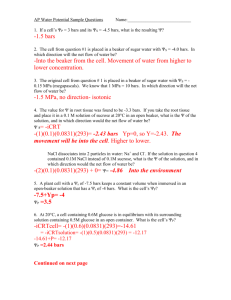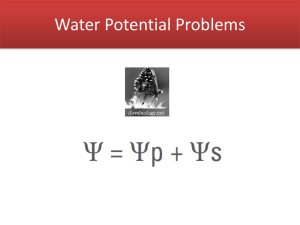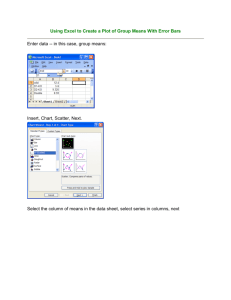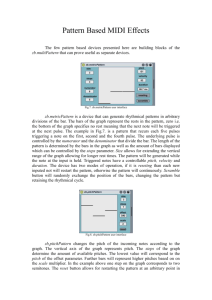Water Potential Practice Problems Answer Key
advertisement
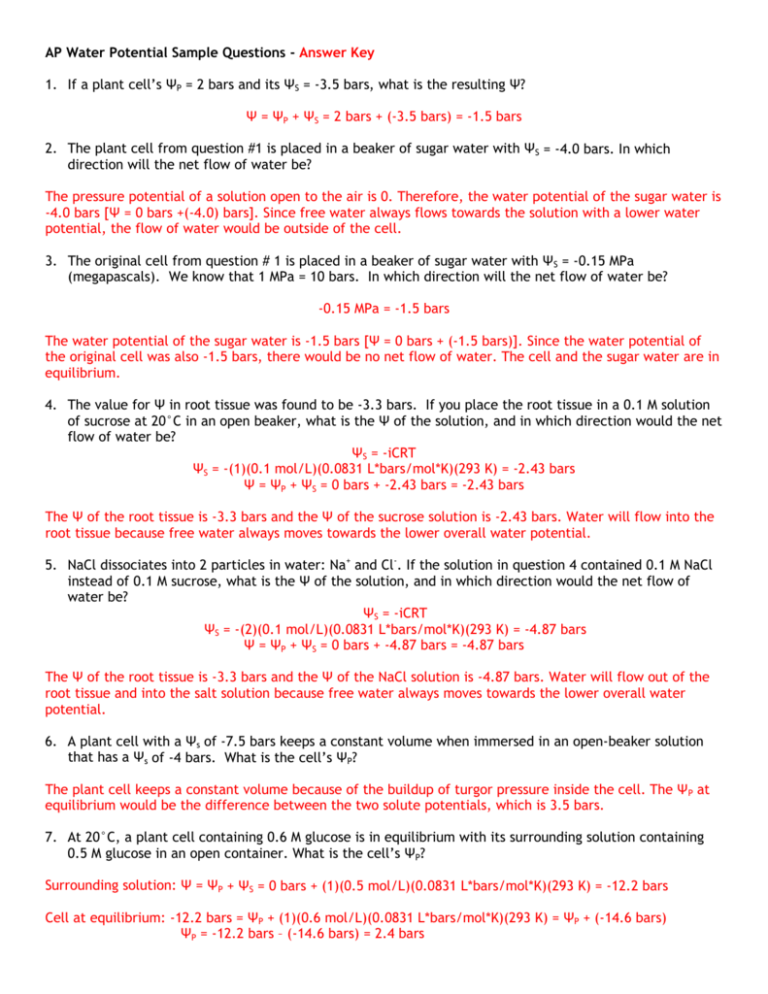
AP Water Potential Sample Questions - Answer Key 1. If a plant cell’s ΨP = 2 bars and its ΨS = -3.5 bars, what is the resulting Ψ? Ψ = ΨP + ΨS = 2 bars + (-3.5 bars) = -1.5 bars 2. The plant cell from question #1 is placed in a beaker of sugar water with ΨS = -4.0 bars. In which direction will the net flow of water be? The pressure potential of a solution open to the air is 0. Therefore, the water potential of the sugar water is -4.0 bars [Ψ = 0 bars +(-4.0) bars]. Since free water always flows towards the solution with a lower water potential, the flow of water would be outside of the cell. 3. The original cell from question # 1 is placed in a beaker of sugar water with ΨS = -0.15 MPa (megapascals). We know that 1 MPa = 10 bars. In which direction will the net flow of water be? -0.15 MPa = -1.5 bars The water potential of the sugar water is -1.5 bars [Ψ = 0 bars + (-1.5 bars)]. Since the water potential of the original cell was also -1.5 bars, there would be no net flow of water. The cell and the sugar water are in equilibrium. 4. The value for Ψ in root tissue was found to be -3.3 bars. If you place the root tissue in a 0.1 M solution of sucrose at 20°C in an open beaker, what is the Ψ of the solution, and in which direction would the net flow of water be? ΨS = -iCRT ΨS = -(1)(0.1 mol/L)(0.0831 L*bars/mol*K)(293 K) = -2.43 bars Ψ = ΨP + ΨS = 0 bars + -2.43 bars = -2.43 bars The Ψ of the root tissue is -3.3 bars and the Ψ of the sucrose solution is -2.43 bars. Water will flow into the root tissue because free water always moves towards the lower overall water potential. 5. NaCl dissociates into 2 particles in water: Na+ and Cl-. If the solution in question 4 contained 0.1 M NaCl instead of 0.1 M sucrose, what is the Ψ of the solution, and in which direction would the net flow of water be? ΨS = -iCRT ΨS = -(2)(0.1 mol/L)(0.0831 L*bars/mol*K)(293 K) = -4.87 bars Ψ = ΨP + ΨS = 0 bars + -4.87 bars = -4.87 bars The Ψ of the root tissue is -3.3 bars and the Ψ of the NaCl solution is -4.87 bars. Water will flow out of the root tissue and into the salt solution because free water always moves towards the lower overall water potential. 6. A plant cell with a Ψs of -7.5 bars keeps a constant volume when immersed in an open-beaker solution that has a Ψs of -4 bars. What is the cell’s ΨP? The plant cell keeps a constant volume because of the buildup of turgor pressure inside the cell. The ΨP at equilibrium would be the difference between the two solute potentials, which is 3.5 bars. 7. At 20°C, a plant cell containing 0.6 M glucose is in equilibrium with its surrounding solution containing 0.5 M glucose in an open container. What is the cell’s ΨP? Surrounding solution: Ψ = ΨP + ΨS = 0 bars + (1)(0.5 mol/L)(0.0831 L*bars/mol*K)(293 K) = -12.2 bars Cell at equilibrium: -12.2 bars = ΨP + (1)(0.6 mol/L)(0.0831 L*bars/mol*K)(293 K) = ΨP + (-14.6 bars) ΨP = -12.2 bars – (-14.6 bars) = 2.4 bars

